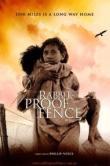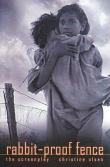AustLit

Latest Issues
AbstractHistoryArchive Description
Based on real life events that occurred in 1931, Rabbit-Proof Fence is the story of three mixed-race Aboriginal children who are forcibly abducted from their mothers by the Western Australian government. Molly (aged fourteen), her sister Daisy (aged eight), and their cousin Gracie (aged ten) are taken from their homes at Jigalong, situated in the Pilbara region of Western Australia, at the orders of the Protector of Aborigines, A.O. Neville, and sent to an institution at Moore River to be educated and trained as domestic servants. After a few days, Molly leads the other two girls in an escape. What ensues is an epic journey that tests the girls' will to survive and their hope of finding the rabbit-proof fence to guide them home.
Although they are pursued by the institution's Aboriginal tracker and the police, Molly knows enough about bush craft to help them hide their tracks. They head east in search of the world's longest fence - built to keep rabbits out - because Molly knows that this will lead them back to Jigalong. Over the course of nine weeks, the girls walk almost 2,400 kilometres before Gracie is captured attempting to catch a train. Molly and Daisy avoid capture but eventually collapse from exhaustion on the saltpans not far from Jigalong. When they wake, they see the spirit bird, an eagle, flying overhead. Its significance gives the girls the extra energy they need and they are able to make it back to their home.
Publication Details of Only Known VersionEarliest 2 Known Versions of
Works about this Work
-
A Historical Review of Aboriginal and Torres Strait Islander Storytelling, Resistance, Reclamation and Education through Film
2023
single work
criticism
— Appears in: Journal of Australian Indigenous Issues , December vol. 26 no. 3-4 2023; -
Rabbit-Proof Fence at 20 : ‘It was such a tough gig for three young blackfellas’
2022
single work
essay
— Appears in: The Guardian Australia , 3 September 2022; -
David Dalaithngu's Screen Presence Changed Australia's Film Industry Forever. Here's a Look at Some of His Major Roles
2021
single work
column
— Appears in: ABC News [Online] , November 2021; -
The Stakes of Settlement : Fences in Ned Kelly and Michael Farrell
2021
single work
essay
— Appears in: Cordite Poetry Review , August no. 102 2021;'William Blake’s articulation of the ‘bounding line’ as ‘the great and golden rule of art, as well as of life’ may seem a far-fetched place to start an examination of the poetics of the fence in Australian poetry. The line’s cosmic necessity and ethical force were being asserted by Blake in the context of a long-running dispute amongst art theorists as to whether outline or colour was the predominant element in the pictorial arts. But my mind reverts to this quotation when thinking about the cathected attitude to lines, boundaries, and fences that is emblematic of the settler-colonial establishment in this country in both its agrarian and suburban contexts.' (Introduction)
-
Indigenous Art, Beyond Stereotypes
2021
single work
essay
— Appears in: Meanjin , Autumn vol. 80 no. 1 2021;'Throughout her stage and screen career, the actor Ningali Lawford-Wolf used the English she only began learning in earnest at about age 11 for diplomatic reasoning. She spoke three Indigenous languages too. Born circa 1967 in the large remote Aboriginal community of Wangkatjungka, 100 kilometres south-east of Fitzroy Crossing in the Western Australian Kimberley region, Lawford-Wolf would go on to appear in films such as Phillip Noyce’s Rabbit-Proof Fence, released in 2002, playing Maude, the mother of two of three little girls stolen from their families, based on a true story that chimed with her own: her father, who worked on a cattle farm, had forcibly been removed from his parents too.' (Introduction)
-
Untitled
2003
single work
review
— Appears in: Fiction Focus : New Titles for Teenagers , vol. 17 no. 1 2003; (p. 31-32)
— Review of Rabbit-Proof Fence 2002 single work film/TV -
Untitled
2003
single work
review
— Appears in: JAS Review of Books , June no. 16 2003;
— Review of Rabbit-Proof Fence 2002 single work film/TV -
Untitled
2003
single work
review
— Appears in: Australasian Drama Studies , October no. 43 2003; (p. 179-183)
— Review of Dirty Deeds 2002 single work film/TV ; Rabbit-Proof Fence 2002 single work film/TV -
A Heartfelt but Limited Work
2002
single work
review
— Appears in: World Socialist Web Site 1993-;
— Review of Rabbit-Proof Fence 2002 single work film/TV -
CoverNotes
2002
single work
review
— Appears in: The Sunday Age , 20 January 2002; (p. 11)
— Review of Eyes in the Dark 2001 single work picture book ; Rabbit-Proof Fence 2002 single work film/TV -
Out Takes
2002
single work
column
— Appears in: The Australian , 15 November 2002; (p. 20) -
'This Is a True Story' : Rabbit-Proof Fence, 'Mr Devil' and the Desire to Forget
2002
single work
criticism
— Appears in: Cultural Studies Review , May vol. 8 no. 1 2002; (p. 117-129) Discusses the reception and historical background of the film. -
Back Tracking
2003
single work
criticism
— Appears in: Meanjin , vol. 62 no. 1 2003; (p. 59-68) Examines some issues raised by the making of Australian films about Aboriginal people in historical settings by white filmmakers. -
'Echoes Across the Flats' : Storytelling and Phillip Noyce's Rabbit Proof Fence (2002)
2002
single work
essay
— Appears in: Southerly , vol. 62 no. 3 2002; (p. 107-117) -
The Battle Against Forgetting
2002
single work
criticism
— Appears in: The Sydney Morning Herald , 11 April 2002; (p. 14)
Awards
- 2002 winner Film Critics Circle of Australia — Best Screenplay - Adapted — Best Screenplay - Adapated
- 2002 Nominated Australian Film Institute Awards — Best Screenplay Adapted from Another Source
- 2001 winner Queensland Premier's Literary Awards — Best Film or Television Script
- 2001 winner Queensland Premier's Literary Awards — Best Film Script
- 2001 winner New South Wales Premier's Literary Awards — Multicultural NSW Award
- Moore River, Guilderton - Gingin area, Southwest Western Australia, Western Australia,
- Moore River Native Settlement (1918-1951), Western Australia,
- 1930s






